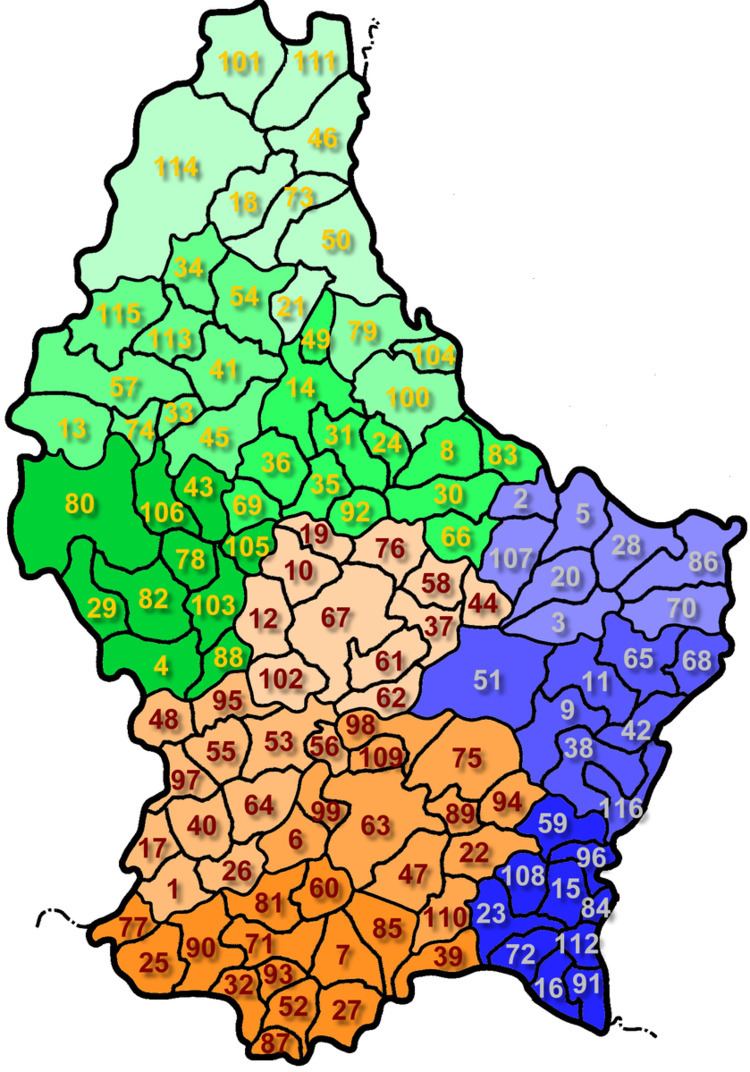 | ||
The communes of Luxembourg (Luxembourgish: Gemengen, German: Gemeinden) are the lowest nationwide administrative division in Luxembourg. They conform to LAU level 2. Luxembourg has 105 communes.
Contents
Within the hierarchy of administrative subdivisions, communes come directly below cantons, which are (in turn) directly below districts. Communes are often re-arranged, being merged or divided as demographic change demands. Unlike the cantons, which have remained unchanged since their creation, the identity of communes has not become ingrained within the understanding of national geography. However, the cantons perform ceremonial, administrative, and statistical purposes, but do not provide local government services, which are all performed by the communes.
The system was first adopted when Luxembourg was annexed into the French département of Forêts, in 1795. Despite ownership passing to the Netherlands, the commune system was maintained until independence in 1839, whereupon they were enshrined in Luxembourgian law (in 1843). Since Luxembourg had little sovereignty of its own before it received independence, and also included the larger Belgian province of Luxembourg, this article deals only with the commune system from 1839 until the present day.
Powers of the communes
The communes have no legislative power or control over matters relating to the national interest, which reside solely with the Chamber of Deputies. However, below that, the communes have wide-ranging powers. They are required by law to provide public education, maintain the local road network, maintain basic public health, and provide some social security. Communes also have discretionary powers (described as missions morales: moral duties) in the fields of supply of water, gas, and electricity; comprehensive health care (including maintenance of hospitals and clinics); land use planning; culture and sport; and provision of care to the elderly.
Current communes
There are currently 105 communes, divided across the twelve cantons. 12 communes out of 105 communes have city status.
Former communes
Since the country's creation in 1839, thirty-four communes have been merged to reach the number of 105 communes that exist today (2015). The defunct communes are:
Evolution of communes
The commune system was created during the French occupation to mirror the systems employed in the rest of the French Republic. These were overhauled in 1823, but the system itself was retained until independence, which was granted under the 1839 Treaty of London. The law regulating their creation and organisation dates to 24 February 1843, which was later enshrined in the Luxembourgian constitution, promulgated on 17 October 1868.
Upon independence, there were 120 communes. A chain of demegers and partitions between 1849 and 1891 increased this number to 130. Most of these were brought about by asymmetrical population growth, as population growth in the south caused the balance of population in the country to shift; some of the communes born in that era include Rumelange, Schifflange, and Walferdange. In what is now termed 'Nordstad', Erpeldange and Schieren were separated from Ettelbruck.
However, from the end of the First World War, during which Luxembourg was occupied by Germany, the number of communes has dropped. In 1920, Luxembourg City was greatly expanded, annexing four surrounding communes. Another wave of mergers took place in the late 1970s, when sparsely-populated areas in the north and west of the country were merged to form Lac de la Haute-Sûre, Rambrouch, and Wincrange. 2006 saw the creation of Kiischpelt and Tandel from four smaller communes, further reducing the number of communes to 116. 2012 saw the creation of Käerjeng, Vallée de l'Ernz and Parc Hosingen from smaller communes, and the expansion of Clervaux, Esch-sur-Sûre and Schengen with adjacent communes. With the 2015 expansion of Wiltz, the number of communes to the present has been reduced to 105.
Cities
Twelve of the communes of Luxembourg have the status of cities. They are:
